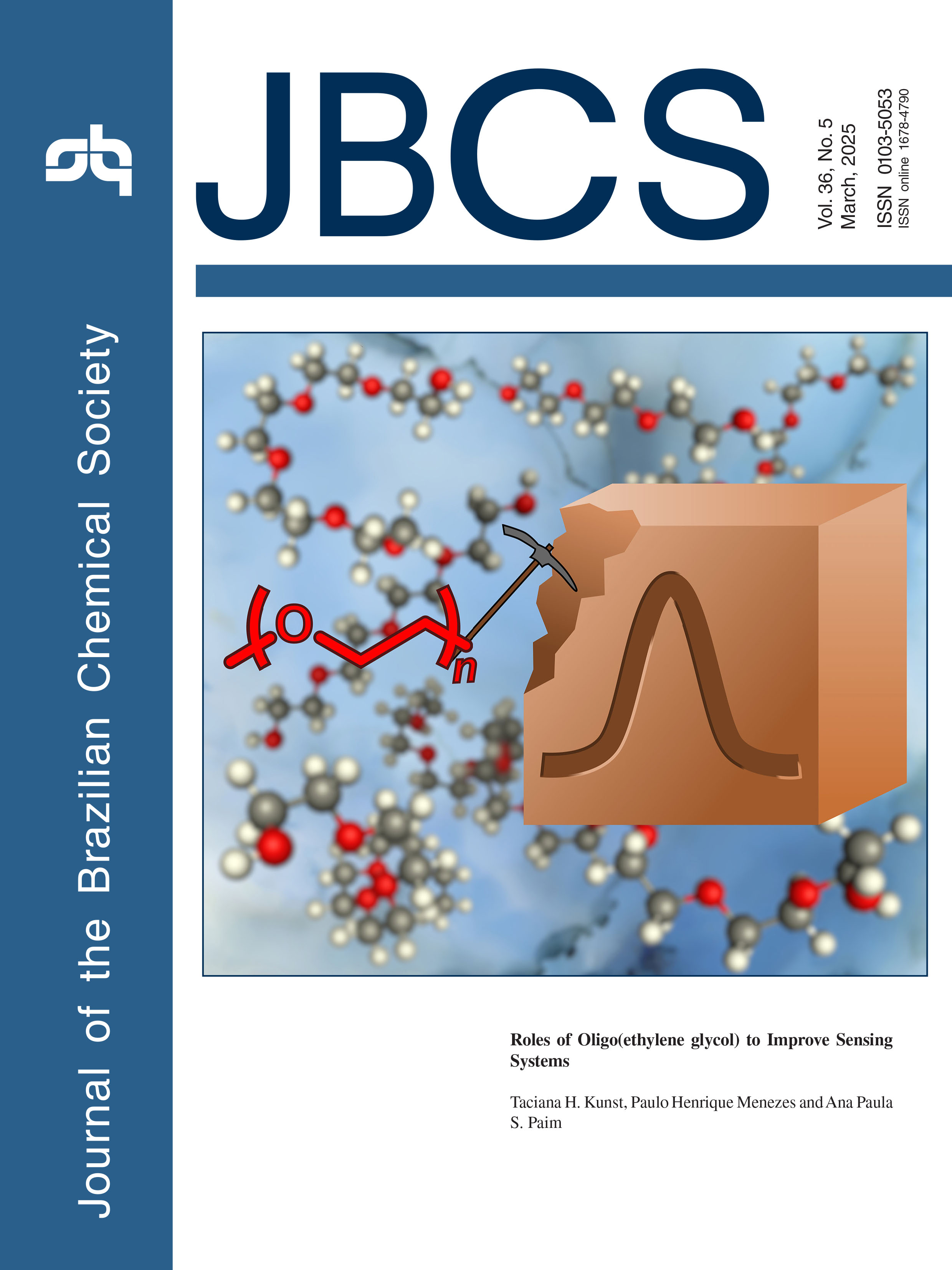vol. 36, No. 5, 2025
Oligo(ethylene glycol) chains (OEGs) can improve analytical responses, perfecting sensing systems as a masterpiece. Although OEGs have been used in sensing systems for more than 25 years, they did not receive proper attention. But now, OEGs will emerge as useful tools to the development of novel or existing sensing systems. Eleven roles played by the OEGs in the sensing systems are known, but more might be discovered. Details are presented in the Review Roles of Oligo(ethylene glycol) to Improve Sensing Systems by Taciana H. Kunst, Paulo Henrique Menezes and Ana Paula S. Paim on e-20250003.
Roles of Oligo(ethylene glycol) to Improve Sensing Systems
Taciana H. Kunst; Paulo Henrique Menezes  ; Ana Paula S. Paim
; Ana Paula S. Paim
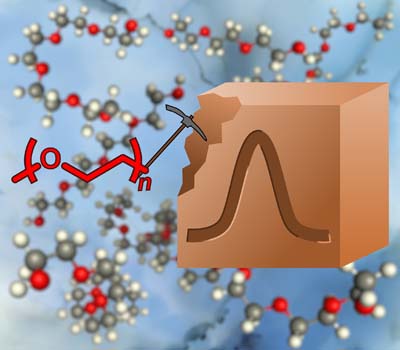
Oligo(ethylene glycol) chains (OEGs) can improve analytical responses, perfecting sensing systems as a masterpiece. Although OEGs have been used in sensing systems for more than 25 years, they did not receive proper attention. But now, OEGs will emerge as useful tools to the development of novel or existing sensing systems. Eleven roles played by the OEGs in the sensing systems are known, but more might be discovered. Details are presented in the Review Roles of Oligo(ethylene glycol) to Improve Sensing Systems by Taciana H. Kunst, Paulo Henrique Menezes and Ana Paula S. Paim on e-20250003.
https://dx.doi.org/10.21577/0103-5053.20250003
Review J. Braz. Chem. Soc. 2025, 36(5), e-20250003, 1-9
Roles of Oligo(ethylene glycol) to Improve Sensing Systems
Taciana H. Kunst; Paulo Henrique Menezes  ; Ana Paula S. Paim
; Ana Paula S. Paim
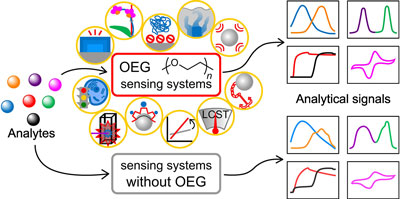
Oligo(ethylene glycol) (OEG) can play several roles in sensing systems. The OEG-containing sensing systems are shown to be advantageous as the OEG improves their performance in the analysis of distinct analytes by different techniques.
https://dx.doi.org/10.21577/0103-5053.20250003
Articles J. Braz. Chem. Soc. 2025, 36(5), e-20240194, 1-10
Analysis of Cocaine, Benzoylecgonine, and Ecgonine Methyl Ester in Hair Strands Via Matrix-Assisted Laser Desorption Ionization Mass Spectrometry (MALDI-MS)
Patrícia Donateli; Nayara A. dos Santos  ; Sébastien Charneau; Marcelo V. de Sousa; Bruno D. Sabino; Wanderson Romão
; Sébastien Charneau; Marcelo V. de Sousa; Bruno D. Sabino; Wanderson Romão
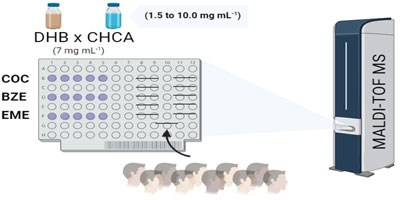
MALDI(+)TOF MS (matrix-assisted laser-desorption and ionization time-of-flight mass spectrometry) for the rapid detection of cocaine (COC), benzoylecgonine (BZE), and ecgonine methyl ester (EME) in hair strands.
https://dx.doi.org/10.21577/0103-5053.20240194
J. Braz. Chem. Soc. 2025, 36(5), e-20240195, 1-11
Influence of Current Density and Chloride Concentration on the Electrooxidation of Ammonia and Organic Matter in Ammonia-Laden Effluents
Caroline R. S. Brigido  ; Flávio A. Lemos; Iranildes D. dos Santos
; Flávio A. Lemos; Iranildes D. dos Santos  ; Achilles J. B. Dutra
; Achilles J. B. Dutra
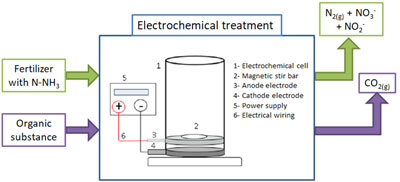
The study aimed to degrade ammonia nitrogen and organic matter in effluent generated at a port terminal used for fertilizer storage. The results indicated removal of 99.99% of N-NH3 and 75.60% of total organic carbon (TOC).
https://dx.doi.org/10.21577/0103-5053.20240195
J. Braz. Chem. Soc. 2025, 36(5), e-20240196, 1-16
Volatile and Non-Volatile Compounds Profiling of Brazilian Pitanga (Eugenia uniflora L.) Varieties During Ripening using Gas Chromatography-Mass Spectrometry Approach
Grazieli B. Pascoal  ; Silvia L. R. Meza
; Silvia L. R. Meza  ; Eric C. Tobaruela
; Eric C. Tobaruela  ; Rodrigo Cezar Franzon; Isabel L. Massaretto; Eduardo Purgatto
; Rodrigo Cezar Franzon; Isabel L. Massaretto; Eduardo Purgatto
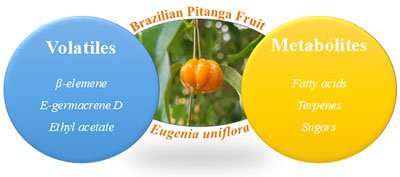
The Brazilian pitanga fruits exhibited volatile compounds such as esters, terpenes and aldehydes, with β-elemene, E-germacrene and ethyl acetate being the most abundant. Additionally, 124 polar and non-polar metabolites were identified, notably including fatty acids, sugars and terpenes, which possess potential health-promoting effects.
https://dx.doi.org/10.21577/0103-5053.20240196
J. Braz. Chem. Soc. 2025, 36(5), e-20240197, 1-12
Dye Contaminant Removal: Adsorption on Thermoplastic Starch/Kraft Lignin Composites and Photodegradation
Amanda S. M. de Freitas  ; Jéssica S. Rodrigues
; Jéssica S. Rodrigues  ; Stefanny F. Amaro
; Stefanny F. Amaro  ; Beatriz M. Ramos; Marystela Ferreira
; Beatriz M. Ramos; Marystela Ferreira
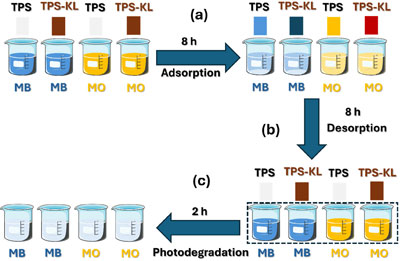
Experimental steps: adsorption of the dyes used (methylene blue (MB) and methyl orange (MO)) present in the solution in thermoplastic starch films (TPS) and TPS/kraft lignin (TPS-KL) (a), followed by desorption of the dyes present in the films in water (b), and subsequent remediation with exposure to photodegradation of the dyes desorbed in water (c).
https://dx.doi.org/10.21577/0103-5053.20240197
J. Braz. Chem. Soc. 2025, 36(5), e-20240198, 1-10
Synthesis and Evaluation of Biological Activities of Thieno-[2,3-d]-pyrimidine Derivatives
Yue Guo  ; Chenglu Qian; Rongrong Yang; Zhongfei Han; Guoxiang Sun
; Chenglu Qian; Rongrong Yang; Zhongfei Han; Guoxiang Sun  ; Yaquan Sun
; Yaquan Sun
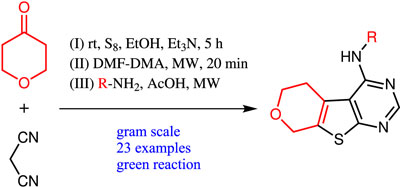
Twenty three thiophene[2,3-d]pyrimidine derivatives were synthesized by a 3-step reaction, and the bioactivity of the synthesized compounds was evaluated by breast cancer cell MDA-MB-231.
https://dx.doi.org/10.21577/0103-5053.20240198
J. Braz. Chem. Soc. 2025, 36(5), e-20240199, 1-10
The Influence of the Acyl Side Chain on Pyrene Excimer Formation as a Model for Asphaltene Aggregation
Suyane D. S. de Alvarenga; Simon J. Garden; Josué S. B. Forero; Raquel S. P. Teixeira; Rodrigo S. Souza; Yan M. H. Gonçalves; Bruno A. C. Horta; Javier A. G. Gomez; Luiz H. C. dos Santos; Emerson S. Ribeiro  ; Rodrigo J. Corrêa
; Rodrigo J. Corrêa
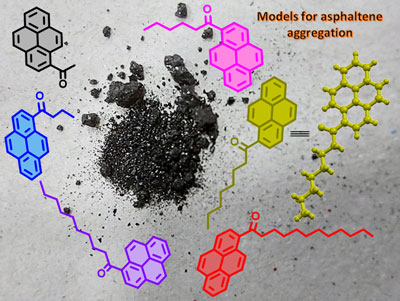
Acyl pyrenes as models for asphaltene aggregation.
https://dx.doi.org/10.21577/0103-5053.20240199
J. Braz. Chem. Soc. 2025, 36(5), e-20240200, 1-21
Synthesis, Antileishmanial Activity, and in silico Study of 2-Hydroxy‑3‑(1,2,3‑triazolyl)propyl Vanillin Derivatives
Samira S. Santiago  ; Camila S. Freitas
; Camila S. Freitas  ; Adilson V. Costa
; Adilson V. Costa  ; Mariana B. de Oliveira
; Mariana B. de Oliveira  ; Aidene F. C. Faria
; Aidene F. C. Faria  ;
;
William S. Belarmino  ; Gisely F. Moura
; Gisely F. Moura  ; Nayara A. dos Santos
; Nayara A. dos Santos  ; Wanderson Romão
; Wanderson Romão  ; Valdemar Lacerda Júnior
; Valdemar Lacerda Júnior  ;
;
Fabrício M. de Oliveira  ; Osmair V. Oliveira; Eduardo A. F. Coelho
; Osmair V. Oliveira; Eduardo A. F. Coelho  ; Róbson R. Teixeira
; Róbson R. Teixeira
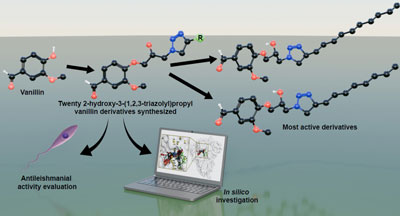
The synthesis, antileishmanial assay, and in silico analysis of twenty 2-hydroxy-3-(1,2,3-triazolyl)propyl vanillin derivatives are reported.
https://dx.doi.org/10.21577/0103-5053.20240200
J. Braz. Chem. Soc. 2025, 36(5), e-20240201, 1-10
Novel Terpene-Reinforced Photopolymerizable Resins Derived from Methacrylate Salts of Imidazole
Ilária M. S. Lins  ; Anderson G. Vieira
; Anderson G. Vieira  ; Rubson P. S. Ribeiro
; Rubson P. S. Ribeiro  ; Dayane K. D. N. Santos
; Dayane K. D. N. Santos  ; Larissa G. Maciel
; Larissa G. Maciel  ; Petrus A. Santa-Cruz
; Petrus A. Santa-Cruz  ; Severino Alves Júnior
; Severino Alves Júnior  ; Janaína V. dos Anjos
; Janaína V. dos Anjos
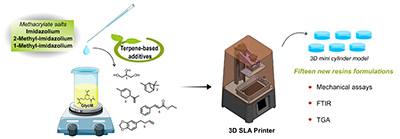
This study explores 3D printable resin blends with terpene additives, yielding fifteen formulations. These resins hold promise for drug delivery and the fabrication of biomedical devices.
https://dx.doi.org/10.21577/0103-5053.20240201
J. Braz. Chem. Soc. 2025, 36(5), e-20240202, 1-14
Exploring the Potential of Waste Biomass from the Brazilian Legal Amazon in Bioproducts Production: a Comprehensive Analysis and Promising Perspectives
Mariana S. Borges  ; Jéssyka R. Santos
; Jéssyka R. Santos  ; Marcelo M. Pedroza
; Marcelo M. Pedroza  ; Magale K. D. Rambo
; Magale K. D. Rambo  ; Daniel B. Assumpção
; Daniel B. Assumpção  ;
;
Clarissa P. Frizzo  ; Robert A. Burrow
; Robert A. Burrow  ; Elisandra Scapin
; Elisandra Scapin
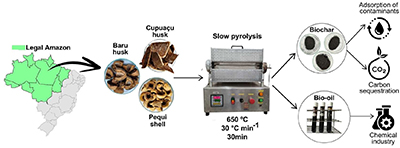
Residual biomass from the Legal Amazon was used in a slow pyrolysis process. The biochars showed potential for carbon sequestration and contaminant adsorption, while bio-oils, containing phenols and furans, could serve as raw materials in the chemical industry.
https://dx.doi.org/10.21577/0103-5053.20240202
J. Braz. Chem. Soc. 2025, 36(5), e-20240216, 1-16
Computational and Experimental Study of PVA with F127 and Citric Acid for Electrospinning
Ariane Regina S. Rossin; Vinicius Martinelli; Ernani A. Basso  ; Mariana S. Gibin; Vitor S. Zanuto; Bruno Henrique Vilsinski
; Mariana S. Gibin; Vitor S. Zanuto; Bruno Henrique Vilsinski  ;
;
Eduardo Radovanovic  ; Wilker Caetano; Douglas C. Dragunski
; Wilker Caetano; Douglas C. Dragunski
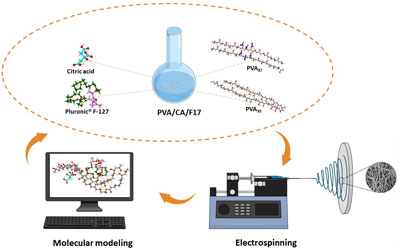
The conformation of polymer chains in solution and interactions with additional components can be studied computationally to improve electrospinning parameters.
https://dx.doi.org/10.21577/0103-5053.20240216
J. Braz. Chem. Soc. 2025, 36(5), e-20240218, 1-7
Higenamine Detection and Metabolism Study Using High-Performance Liquid Chromatography Coupled to AgIII-Luminol Chemiluminescence
Haoran Wang; Hanyu Sha; Mengying Liu; Hongmei Shi; Li Ma
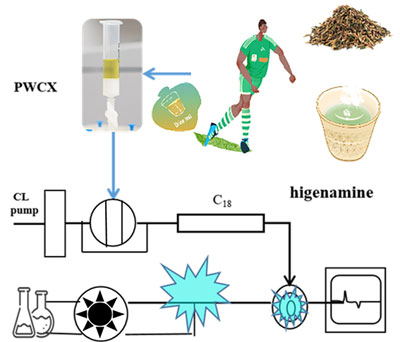
Detection method of higenamine in food and urine and metabolism study.
https://dx.doi.org/10.21577/0103-5053.20240218
J. Braz. Chem. Soc. 2025, 36(5), e-20240219, 1-16
Study of the Chemical Diversity in Spondias tuberosa Leaves During the Phenological Evolution Stages: Metabolomic and Chemometric Approaches Associated with Antioxidant and Antiglycant Activities
Francisco Wendell M. do Nascimento; Tamyris A. Gondim; Paulo R. V. Ribeiro; Maria Auxiliadora C. de Lima; Viseldo R. de Oliveira; João Francisco Câmara Neto; Maria Elenir N. P. Ribeiro; Anna Beatriz S. Ferrari; Maria Luiza Zeraik  ; Jhonyson A. C. Guedes
; Jhonyson A. C. Guedes  ; Guilherme J. Zocolo
; Guilherme J. Zocolo
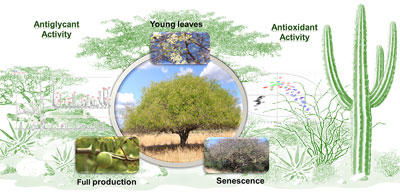
Evaluation of chemodiversity, antioxidant and antiglycant activities of Spondias tuberosa leaves during different stages of plant development.
https://dx.doi.org/10.21577/0103-5053.20240219
J. Braz. Chem. Soc. 2025, 36(5), e-20240226, 1-11
Sensitive Determination of Bisphenol A In Urine Using Automated Solid-Phase Extraction Followed by LC-MS/MS Analysis: Application to a Human Biomonitoring Study in Brazil
Camila F. de Souza  ; Giovana P. Peteffi; Cloé D. Loredo; Marcos F. Bastiani; Amanda P. Bondan; Giovanna S. Grassi;
; Giovana P. Peteffi; Cloé D. Loredo; Marcos F. Bastiani; Amanda P. Bondan; Giovanna S. Grassi;
Carolina W. Ferrareze; Paola Winter; Roberta Z. Hahn; Marina V. Antunes; Rafael Linden
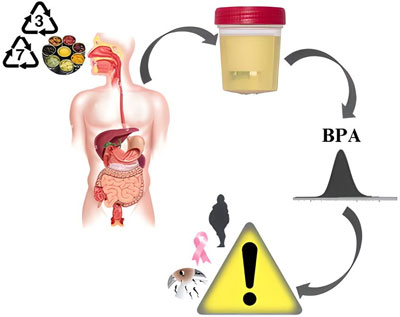
Determination of bisphenol A in urine samples using automated solid-phase extraction followed by liquid chromatography-tandem mass spectroscopy (LC-MS/MS) analysis.
https://dx.doi.org/10.21577/0103-5053.20240226
J. Braz. Chem. Soc. 2025, 36(5), e-20240227, 1-9
Extracts from Tissue Cultures of Crotalaria spp. as Potential Natural Alternative for Controlling Root-Knot Nematodes
Amanda P. Honório; Daiane E. Blank; Antonio J. Demuner  ; Gustavo S. F. Souza
; Gustavo S. F. Souza  ; Dalila S. Buonicontro; Eduardo V. V. Varejão
; Dalila S. Buonicontro; Eduardo V. V. Varejão  ; Guilherme J. Zocolo
; Guilherme J. Zocolo  ; Jhonyson A. C. Guedes
; Jhonyson A. C. Guedes  ; Maria J. M. Firmino; Jilma L. B. R. D. Carvalho; Marcelo H. Santos; Daniele V. Faria; Lorena M. Vieira; Wagner C. Otoni; Franklin J. Machado
; Maria J. M. Firmino; Jilma L. B. R. D. Carvalho; Marcelo H. Santos; Daniele V. Faria; Lorena M. Vieira; Wagner C. Otoni; Franklin J. Machado
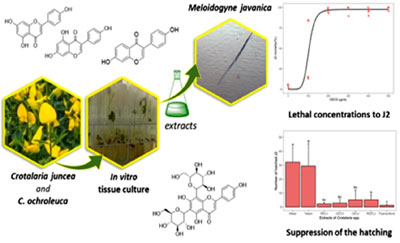
Crotalaria juncea and Crotalaria ochroleuca were cultivated in vitro and the extracts from the callus exhibited high toxicity against Meloidogyne javanica. This effect could be phenolic compounds, alkaloids and flavonoids contents identified in these extracts.
https://dx.doi.org/10.21577/0103-5053.20240227
J. Braz. Chem. Soc. 2025, 36(5), e-20250001, 1-10
Chitosan Pretreatment: Evidence of Enhanced Mechanical Stability and Adsorption Capacity to Produce a Hybrid Material
Sueslley G. G. Rodrigues; Gisele S. Lopes  ; Elisane Longhinotti
; Elisane Longhinotti  ; Izaura C. N. Diógenes
; Izaura C. N. Diógenes
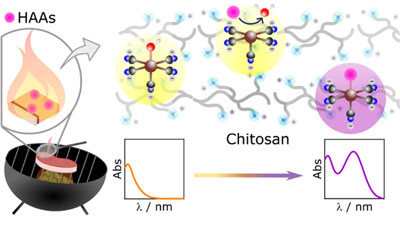
A sustainable hybrid material composed of chitosan biopolymer incorporated with an iron complex was developed for the effective detection of heterocyclic aromatic amines (HAAs), which are possible carcinogens formed during food heat processing.
https://dx.doi.org/10.21577/0103-5053.20250001
J. Braz. Chem. Soc. 2025, 36(5), e-20250006, 1-5
Sustainable Water Management for Steam Generation in Sugarcane Biorefineries: Applying PCA and MST Clustering in Sample Analysis
Érik Geraldo S. Souza  ; Fabiola M. V. Pereira
; Fabiola M. V. Pereira
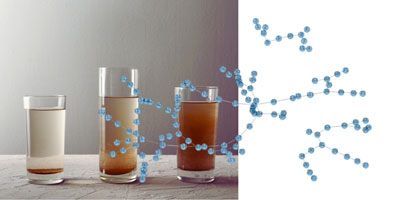
Our study on sustainable water management for steam generation in sugarcane biorefineries utilized unsupervised methods such as principal component analysis (PCA) and minimum spanning tree (MST) to assess water quality, providing valuable insights for optimizing bioenergy efficiency and sustainability.
https://dx.doi.org/10.21577/0103-5053.20250006
J. Braz. Chem. Soc. 2025, 36(5), e-20250007, 1-7
A New Non-Cyanogenic Cyanoglycoside with Promising α-Glycosidase Inhibitory Activity from the Roots of Cordia trichotoma
Késya A. D. Rocha  ; Francisca R. S. Lopes; Francisco C. L. Pinto
; Francisca R. S. Lopes; Francisco C. L. Pinto  ; Francisco M. G. N. Pinheiro
; Francisco M. G. N. Pinheiro  ; Samuel P. D. Marques
; Samuel P. D. Marques  ;
;
Maria Teresa S. Trevisan  ; Edilberto R. Silveira
; Edilberto R. Silveira  ; Otília D. L. Pessoa
; Otília D. L. Pessoa  ; Gilvandete M. P. Santiago
; Gilvandete M. P. Santiago
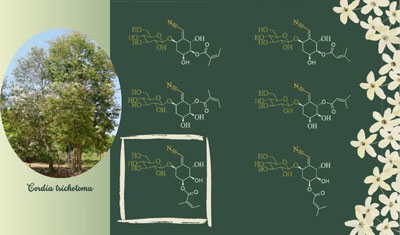
Six non-cyanogenic cyanoglycosides, three of which are new, were isolated from the roots of Cordia trichotoma. The new highlighted compound (3) showed a promising α-glycosidase inhibitory activity.
https://dx.doi.org/10.21577/0103-5053.20250007
J. Braz. Chem. Soc. 2025, 36(5), e-20250009, 1-9
Use of Greenhouse Cell for Rhodamine B (RhB) Removal
Mokhtar Djehiche  ; Marwa Bachiri; Nedjma Lahmar
; Marwa Bachiri; Nedjma Lahmar

Solar thermal heating is an efficient and environmentally friendly method of heat generation, as it does not produce byproducts typically associated with artificial heating processes.
https://dx.doi.org/10.21577/0103-5053.20250009
J. Braz. Chem. Soc. 2025, 36(5), e-20250010, 1-9
A Spectrophotometric Study of the Interaction of Quercetin and Tannic Acid with Mimetic Systems of Cancerous and Healthy Cells
Pablo A. Oliveira  ; Leandro A. Mendes
; Leandro A. Mendes  ; Vitor O. Silva
; Vitor O. Silva  ; Paulo V. Scarparo
; Paulo V. Scarparo  ; Layra C. Conceição
; Layra C. Conceição  ; Pedro I. S. Maia
; Pedro I. S. Maia  ; Jéferson A. Moreto
; Jéferson A. Moreto  ; Natália B. L. Slade
; Natália B. L. Slade
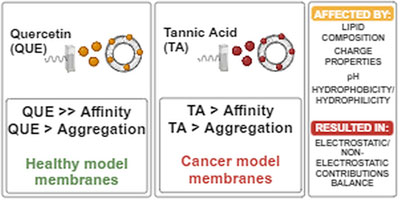
Spectrophotometric study of the interaction between quercetin and tannic acid with model membranes of healthy and cancer cells.
https://dx.doi.org/10.21577/0103-5053.20250010
J. Braz. Chem. Soc. 2025, 36(5), e-20250011, 1-8
Evaluation of the Uncertainty in the Measurement of Nanoparticle Size and Concentration by Single Particle Inductively Coupled Plasma Mass Spectrometry Technique
Adriana N. Geraldes  ; Marcos A. Hortellani
; Marcos A. Hortellani  ; Maria Elisa C. M. Rostelato; Jorge E. S. Sarkis
; Maria Elisa C. M. Rostelato; Jorge E. S. Sarkis

The identification and quantification of sources contributing to measurement uncertainties were evaluated using single-particle inductively coupled plasma mass spectrometry (sp-ICP-MS) with National Institute of Standards and Technology (NIST) reference material RM 8017.
https://dx.doi.org/10.21577/0103-5053.20250011
J. Braz. Chem. Soc. 2025, 36(5), e-20250012, 1-12
Drug Repurposing Strategy to Develop New AZT Derivatives Targeting SARS‑CoV-2 Mpro: Synthesis, Computational Studies, and Enzymatic Evaluation
Pedro A. B. Morais  ; Natália A. Guedes; Caroline S. Fontes; Poliana A. R. Gazolla; Heberth de Paula; Walter C. C. Bigui;
; Natália A. Guedes; Caroline S. Fontes; Poliana A. R. Gazolla; Heberth de Paula; Walter C. C. Bigui;
Wanderson Romão  ; Gabriela V. Costa; Adilson V. Costa
; Gabriela V. Costa; Adilson V. Costa  ; Vagner T. de Queiroz; Valdemar Lacerda Júnior
; Vagner T. de Queiroz; Valdemar Lacerda Júnior
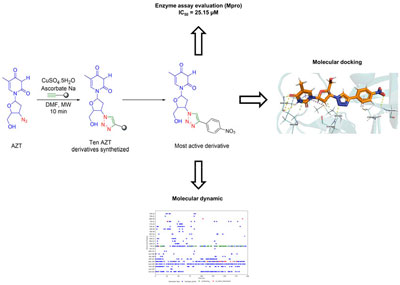
Synthesis and inhibitory activity against main protease of SARS-CoV-2 of AZT (3'-azido-3'-deoxythymidine) 1,2,3-triazole derivatives supported by molecular dynamics.
https://dx.doi.org/10.21577/0103-5053.20250012
J. Braz. Chem. Soc. 2025, 36(5), e-20250014, 1-7
Influence of Adding High Flash Point, Special Jet Fuel for Brazilian Navy (QAV-5), in Brazilian Marine Gasoil (ODM), on Fuel Viscosity, Specific Gravity, Cetane Index and Lubricity
Camila R. Louzeiro; Cristiane G. de Souza; Débora F. de Andrade; Luiz A. d'Avila
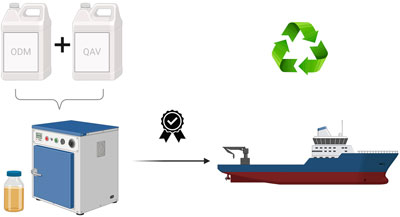
Mixture of marine diesel oil with aviation kerosene undergoes accelerated oxidation in an oven to analyze its physical-chemical properties to assess whether it can be used on Brazilian navy ships without harm.
https://dx.doi.org/10.21577/0103-5053.20250014
J. Braz. Chem. Soc. 2025, 36(5), e-20250015, 1-13
Analysis of Pesticides by Ultra-High Performance Liquid Chromatography in Combination with High Resolution Mass Spectrometry (UPLC-Orbitrap MS): Case Study for Application on River Water Samples in Vietnam
Nam Vu Duc  ; Thuy Minh Le; Xuyen Nguyen Thi; Hoi Bui Van; Cam Tu Vu; Hong An Vu Thi; Dinh Binh Chu
; Thuy Minh Le; Xuyen Nguyen Thi; Hoi Bui Van; Cam Tu Vu; Hong An Vu Thi; Dinh Binh Chu
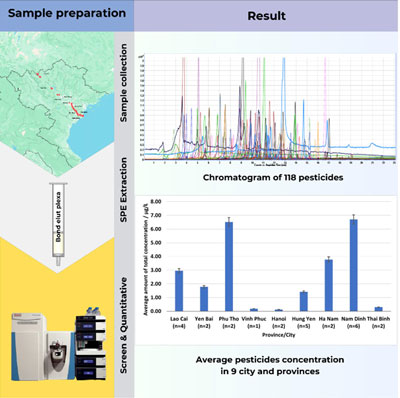
Analysis of screening and quantification for 118 pesticides by ultra-high performance liquid chromatography in combination with high resolution mass spectrometry (UPLC-Orbitrap MS).
https://dx.doi.org/10.21577/0103-5053.20250015
Short Report J. Braz. Chem. Soc. 2025, 36(5), e-20250002, 1-5
One-Pot Sodium Azide-Free Synthesis of Aryl Azides from Anilines
Leonardo G. C. de Moraes  ; Maria Cristina B. Guidinele; Vitor F. Ferreira
; Maria Cristina B. Guidinele; Vitor F. Ferreira  ; David R. da Rocha
; David R. da Rocha
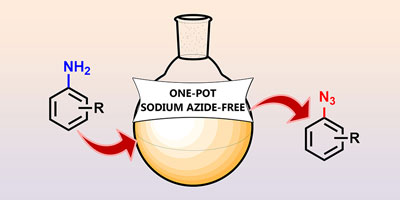
Development of a one-pot methodology for the synthesis of aryl azides maintaining anilines as a molecular framework without the need to use sodium azide.
https://dx.doi.org/10.21577/0103-5053.20250002
Online version ISSN 1678-4790 Printed version ISSN 0103-5053
Journal of the Brazilian Chemical Society
JBCS Editorial and Publishing Office
University of Campinas - UNICAMP
13083-970 Campinas-SP, Brazil
Free access










